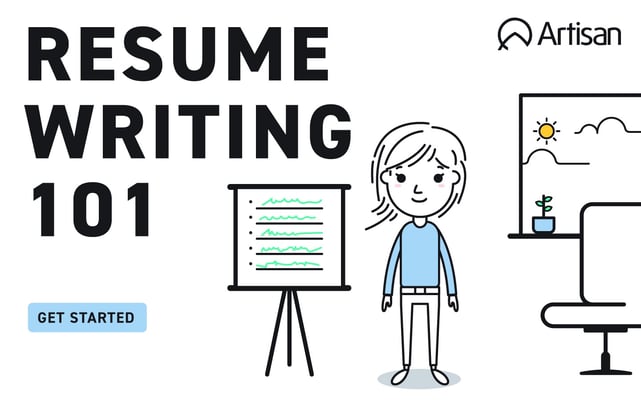23 Tips for a Better Resume
/Strategy.jpg?width=641&height=360&name=Strategy.jpg)
1. Switch up Your Font
USA Today recommends switching the font of your resume to Helvetica, Arial, or Times New Roman—in other words, a font that's easy to read.
2. Get Rid of "References Available Upon Request"
Most employers assume you have references, and that you'll provide them if asked. Save this space for something else.
3. Remove Made Up Words
You're not Shakespeare. Making your own words like "stratergy" will get you noticed, but not in a good way says Director of Operations Ellen Bird.
4. Save it as a PDF
They're easy to open and insure your formatting won't get all wonky.
5. Skip the Objective
They've become a little dated and take up valuable space you could be filling with stats and skills.
6. Read it Out Loud
Steal this Copywriter trick: Reading your resume out loud helps you catch any spelling mistakes or misused words. "If you find yourself tripping over a sentence as you read it, chances are there’s a problem with your grammar or syntax," says ResumeTarget founder Amos Tayts.
7. Include Social Media Links
There's no need for your address anymore, but don't forget to include your professional social handles. Are you an amazing UI Designer that tweets daily tips and tricks? Pop on your @handle by your website and email.
8. Edit for Length
As a rule, says The Muse, "you should only show the most recent 10-15 years of your career history and only include the experience relevant to the positions to which you are applying."
9. Include Numbers
Statistics speak volumes and including numbers helps make sections of your resume pop.
10. Add Volunteer Work
Spent a large amount of time freelance writing or donating your professional skills to a charity or non-profit? Absolutely list these in the body of your resume as their own "jobs."
11. Make Hyperlinks Live
Chances are your resume will be read on a computer, so making things like your LinkedIn profile clickable, makes it easier for the Recruiter to learn more about you.
12. Remove your Graduation Year
If you're more than a couple years out of college, there's no need to list a graduation date. Recruiters usually just want to know that you have a degree.
13. Reduce Your Margins
Need more space without shrinking your font? Try reducing your top and bottom margins to 0.5″ and your side margins to 0.75″.
14. Update Your Skills Section
Recently take a class in Photoshop? Don't forget to add it to your list of skills.
15. Skip the Visuals
Unless you are a Designer or are submitting a carefully crafted creative resume, remove any photos or visual elements says USA Today. On a more traditional resume, they distract from the information at hand and can trip up applicant tracking systems.
16. Mix it Up
If every bullet point starts with "Responsible for..." whoever is reading your resume will get bored. Break out a thesaurus and find some different words.
17. Don't Overuse Buzzwords
Speaking of words, skip overused ones like "detail oriented" and "people person" they're vague and chronically overused. Find a better word to describe how amazing you are.
18. Add Awards
Did you win a Clio like Don Draper? Add a section for awards and include it. "You'd be surprised how many creative professionals fail to include these" says Monster.com.
19. Mac or PC?
If you only have skills in one platform or can work in both, it's important to include that so a Recruiter doesn't pass you over.
20. Include Your Portfolio
Make sure to include a link to your online portfolio or at the very least your LinkedIn profile where someone can see examples of your past work.
21. List Languages
There are lots of jobs for bilingual professionals. Make sure to list other languages you speak even if it doesn't seem relevant. You never know when a Recruiter might be looking for a Spanish speaking Presentation Specialist or German FED.
22. Save it with Your Name.
Ready to attach your resume and send it into the world? Save it as "Regina Falange Resume" instead of just "resume" to help the Hiring Manager out and to make sure it won't get lost in a sea of other "resume" labeled resumes.
23. Write Towards the Future.
Tell the reader what you accomplished in your position, not just your daily tasks. Levo.com says "Too often, resumes are a conglomerate of CliffNotes of prior job descriptions. A job description tells me what you were hired to do, not if you actually did it—and beyond that, if you did it well."
Need More Help Crafting the Perfect Resume?
Check out our downloadable guide to writing resumes! You'll find tips and tricks for crafting the perfect starter resume all in PDF form.
Ready for your resume to see the light of day? Contact one of our Artisan Talent recruiters today, or check out these other resume focused posts...
/Improve%20Your%20Career%20Network.jpg?width=380&name=Improve%20Your%20Career%20Network.jpg)




/GenZ_Communication.jpg?width=436&height=255&name=GenZ_Communication.jpg)